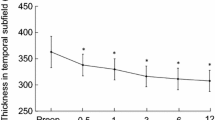Abstract
Purpose
To determine whether the visual field defects detected within 3 months of indocyanine green (ICG)-assisted inner-limiting membrane (ILM) peeling continue to worsen over longer periods.
Methods
This was a retrospective observational case series. Four eyes with visual field defects that developed within 3 years of ICG-assisted ILM peeling for a macular hole (MH) were examined yearly for 10 years. The main outcome measures were the degree of mean deviation (MD) determined by Humphrey perimetry with the 30-2 SITA-Fast program and the best-corrected visual acuity (BCVA).
Results
Four patients were examined yearly for more than 10 years, with a mean duration of follow-up of 139.5 months (11.6 years) and a range of follow-up of 137–156 months (11.4–13 years). The mean (±standard deviation) preoperative MD value was −4.99 ± 3.26 dB, and the mean postoperative MD values were −12.9 ± 1.29 dB after 1 year, −14.1 ± 0.75 dB after 3 years, and −12.73 ± 2.65 dB after 10 years. The mean preoperative BCVA was 0.65 ± 0.26 logarithm of the minimal angle of resolution (logMAR) units, and the postoperative BCVA was 0.21 ± 0.07 logMAR units at 1 year, 0.28 ± 0.21 logMAR units at 3 years, and 0.14 ± 0.06 dB logMAR units at 10 years.
Conclusions
The visual field defects detected soon after ICG-assisted ILM peeling continued to worsen for 3 years, but not thereafter.



Similar content being viewed by others
References
Eshita T, Ishida S, Shinoda K, Kitamura S, Inoue M, Oguchi Y, et al. Indocyanine green can distinguish posterior vitreous cortex from internal limiting membrane during vitrectomy with removal of epiretinal membrane. Retina. 2002;22:104–6.
Gandorfer A, Messmer EM, Ulbig MW, Kampik A. Indocyanine green selectively stains the internal limiting membrane. Am J Ophthalmol. 2001;131:387–8.
Horio N, Horiguchi M. Effect on visual outcome after macular hole surgery when staining the internal limiting membrane with indocyanine green dye. Arch Ophthalmol. 2004;122:992–6.
Rodrigues EB, Meyer CH, Kroll P. Chromovitrectomy: a new field in vitreoretinal surgery. Graefes Arch Clin Exp Ophthalmol. 2005;243:291–3.
Schmidt JC, Meyer CH, Rodrigues EB, Hoerle S, Kroll P. Staining of internal limiting membrane in vitreomacular surgery: a simplified technique. Retina. 2003;23:263–4 (author reply 264).
Mochizuki N, Yamamoto T, Enaida H, Ishibashi T, Yamashita H. Long-term outcomes of 3 surgical adjuvants used for internal limiting membrane peeling in idiopathic macular hole surgery. Jpn J Ophthalmol. 2014;58:455–61.
Haritoglou C, Gandorfer A, Gass CA, Kampik A. Indocyanine green staining and removal of internal limiting membrane in macular hole surgery: histology and outcome. Am J Ophthalmol. 2002;133:587–8 (author reply 588).
Kanda S, Uemura A, Yamashita T, Kita H, Yamakiri K, Sakamoto T. Visual field defects after intravitreous administration of indocyanine green in macular hole surgery. Arch Ophthalmol. 2004;122:1447–51.
Rodrigues EB, Meyer CH, Mennel S, Farah ME. Mechanisms of intravitreal toxicity of indocyanine green dye: implications for chromovitrectomy. Retina. 2007;27:958–70.
Tsuiki E, Fujikawa A, Miyamura N, Yamada K, Mishima K, Kitaoka T. Visual field defects after macular hole surgery with indocyanine green-assisted internal limiting membrane peeling. Am J Ophthalmol. 2007;143:704–5.
Uemura A, Kanda S, Sakamoto Y, Kita H. Visual field defects after uneventful vitrectomy for epiretinal membrane with indocyanine green-assisted internal limiting membrane peeling. Am J Ophthalmol. 2003;136:252–7.
Enaida H, Sakamoto T, Hisatomi T, Goto Y, Ishibashi T. Morphological and functional damage of the retina caused by intravitreous indocyanine green in rat eyes. Graefes Arch Clin Exp Ophthalmol. 2002;240:209–13.
Maia M, Kellner L, de Juan E Jr, Smith R, Farah ME, Margalit E, et al. Effects of indocyanine green injection on the retinal surface and into the subretinal space in rabbits. Retina. 2004;24:80–91.
Machida S, Fujiwara T, Gotoh T, Hasegawa Y, Gotoh A, Tazawa Y. Observation of the ocular fundus by an infrared-sensitive video camera after vitreoretinal surgery assisted by indocyanine green. Retina. 2003;23:183–91.
Tadayoni R, Paques M, Girmens JF, Massin P, Gaudric A. Persistence of fundus fluorescence after use of indocyanine green for macular surgery. Ophthalmology. 2003;110:604–8.
von Jagow B, Hoing A, Gandorfer A, Rudolph G, Kohnen T, Kampik A, et al. Functional outcome of indocyanine green-assisted macular surgery: 7-year follow-up. Retina. 2009;29:1249–56.
Yamashita T, Uemura A, Kita H, Nakao K, Sakamoto T. Long-term outcomes of visual field defects after indocyanine green-assisted macular hole surgery. Retina. 2008;28:1228–33.
Yamashita T, Uemura A, Kita H, Sakamoto T. Analysis of the retinal nerve fiber layer after indocyanine green-assisted vitrectomy for idiopathic macular holes. Ophthalmology. 2006;113:280–4.
The AGIS Investigators. The advanced glaucoma intervention study(AGIS): 7. The relationship between control of intraocular pressure and visual field deterioration. Am J Ophthalmol. 2000;130:429–40.
Armaly MF, Krueger DE, Maunder L, Becker B, Hetherington J Jr, Kolker AE, et al. Biostatistical analysis of the collaborative glaucoma study. I. Summary report of the risk factors for glaucomatous visual-field defects. Arch Ophthalmol. 1980;98:2163–71.
Lochhead J, Jones E, Chui D, Lake S, Karia N, Patel CK, et al. Outcome of ICG-assisted ILM peel in macular hole surgery. Eye (Lond). 2004;18:804–8.
Acknowledgment
This study was in part sponsored by a grant from the Research Committee on Chorioretinal Degeneration and Optic Atrophy, Ministry of Health, Labor, and Welfare of Japan and by a Grant-in-Aid for Scientific Research from the Ministry of Education, Science, and Culture of Japan.
Author information
Authors and Affiliations
Corresponding author
Ethics declarations
Conflicts of interest
M. Nakazawa, None; H. Terasaki, None; T. Yamashita, None; A. Uemura, None; T. Sakamoto, None.
About this article
Cite this article
Nakazawa, M., Terasaki, H., Yamashita, T. et al. Changes in visual field defects during 10-year follow-up for indocyanine green-assisted macular hole surgery. Jpn J Ophthalmol 60, 383–387 (2016). https://doi.org/10.1007/s10384-016-0453-1
Received:
Accepted:
Published:
Issue Date:
DOI: https://doi.org/10.1007/s10384-016-0453-1




